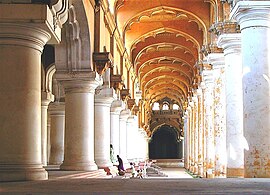Chokkanatha Nayak
| Mannar Chokkanatha Nayakkar | |
|---|---|
| King of Madurai Kingdom | |
| Reign | 1662– 1682C.E. |
| Predecessor | Muttu Alkadri Nayak |
| Successor | Rangakrishna Muthu Virappa Nayak |
| Born | Madurai |
| Died |
Circa 1682 Madurai, present dayTamil Nadu, India |
| Burial | Madurai |
| House | Madurai Nayaks |
| Father | Muttu Alkadri Nayak |
| Kings and Queen Regents of Madurai Nayak Dynasty |
|
|---|---|
| Part of History of Tamil Nadu | |
 |
|
| Madurai Nayak rulers | |
| Viswanatha Nayak | 1529–1563 |
| Kumara Krishnappa Nayak | 1563–1573 |
| Joint Rulers Group I | 1573–1595 |
| Joint Rulers Group II | 1595–1602 |
| Muttu Krishnappa Nayak | 1602–1609 |
| Muttu Virappa Nayak | 1609–1623 |
| Tirumalai Nayak | 1623–1659 |
| Muthu Alakadri Nayak | 1659–1662 |
| Chokkanatha Nayak | 1662–1682 |
| Rangakrishna Muthu Virappa Nayak | 1682–1689 |
| Rani Mangammal‡ | 1689–1704 |
| Vijaya Ranga Chokkanatha Nayak | 1704–1731 |
| Queen Meenakshi‡ | 1731–1736 |
| ‡ Regent Queens | |
| Capitals | |
| Madurai | 1529–1616 |
| Tiruchirapalli | 1616–1634 |
| Madurai | 1634–1665 |
| Tiruchirapalli | 1665–1736 |
| Major forts | |
| Madurai 72 Bastion Fort | |
| Tiruchirapalli Rock Fort | |
| Dindigul Fort | |
| Thirunelvelli Fort | |
| other Military forts | |
| Namakkal Fort | |
| Sankagiri Fort | |
| Attur Fort | |
| Palaces | |
| Thirumalai Nayak Mahal, Madurai | |
| Chokkanatha Nayak Palace a.k.a. Durbar Hall, Tiruchirapalli | |
| Rani Mangammal Tamukkam palace Madurai | |
Chokkanatha Nayak (1662—1682) succeeded his father Muttu Alkadri Nayak,as the ruler of the Madurai Nayak dynasty, when he was sixteen years old. This young ruler began his reign with an ill-considered attempt to drive out the Muslim troops, despatching a large army against the Gingee fortress. His general, however, sold himself to the enemy and wasted time and money in a long and unprofitable campaign which was little but pretence. Chokkanatha was also harassed by a domestic conspiracy, in which the same unfaithful general took a prominent part, and though he detected and quashed this, the general went over openly to the Muslims and induced them to join in an assault upon Trichinopoly, in which they had the countenance, if not the practical assistance, of the Nayakkan (Nayak ruler) of Tanjore. The officers whom Chokkanatha entrusted with the duty of repelling the attack again were disloyal, and it was not until he himself finally took command of the army that the Muslim invaders were driven back to Tanjore and eventually to Gingee.
So far things had not gone so badly, but in the next or the following year (1663 or 1664) Chokkanatha paid a heavy price for his temporary success. The Muslims burst into the Trichinopoly and Madura districts and devastated the country with almost incredible cruelty. They again besieged Trichinoploy, and this time Chokkanatha had to buy them off with a large sum. He consoled himself by punishing the Nayakkan of Tanjore for assisting them, and he attempted similar reprisals on the Setupati of Ramnad, who had failed to help him in repelling them. This latter enterprise was unsuccessful, for though Chokkanatha succeeded in taking several forts in the Marava country, he was baffled by the guerilla tactics of his adversary, and had to retire without obtaining that chief’s submission. This Campaign aspired the Setupati to form a new kingdom.
Chokkantha’s next war was with Tanjore, and it resulted in the capture of that ancient city and the extinction of its Nayakka dynasty, the Vijaya Raghava NayakTanjore Nayaks.
The reason for war was the refusal of the Tanjore Nayak to give his beautiful and gifted daughter in marriage to Chokkanatha. The latter determined to fetch the maiden by force back into their capital, and successfully stormed that place. But they did not get the princess; her eualyye determined father Vijaya Raghava Nayak placed her and all the other ladies of the palace in one room, blew this up with gunpowder and then, with his son and his body-guard, charged furiously into the thickest of the enemy, was captured after a desperate resistance, and was beheaded.
...
Wikipedia
